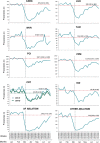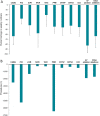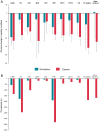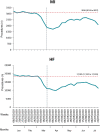Cardiac operations and interventions during the COVID-19 pandemic: a nationwide perspective
- PMID: 33778881
- PMCID: PMC8083650
- DOI: 10.1093/europace/euab013
Cardiac operations and interventions during the COVID-19 pandemic: a nationwide perspective
Abstract
Aims: The COVID-19 pandemic has led to a decline in hospitalizations for non-COVID-19-related conditions. We explored the impact of the COVID-19 pandemic on cardiac operations and interventions undertaken in England.
Methods and results: An administrative database covering hospital activity for England, the Health Episodes Statistics, was used to assess a total of 286 697 hospitalizations for cardiac operations and interventions, as well as 227 257 hospitalizations for myocardial infarction (MI) and 453 799 for heart failure (HF) from 7 January 2019 to 26 July 2020. Over the 3 months of 'lockdown', total numbers and mean reductions in weekly rates [n (-%)], compared with the same time period in 2019, were: coronary artery bypass grafting [-2507 (-64%)]; percutaneous coronary intervention [-5245 (-28%)]; surgical [-1324 (-41%)] and transcatheter [-284 (-21%)] aortic valve replacement; mitral valve replacement; implantation of pacemakers [-6450 (-44%)], cardiac resynchronization therapy with [-356 (-42%)] or without [-491 (-46%)] defibrillation devices, and implantable cardioverter-defibrillators [-501 (-45%)]; atrial fibrillation ablation [-1902 (-83%)], and other ablations [-1712 (-64%)] (all P < 0.001). Over this period, there were 21 038 fewer procedures than in the reference period in 2019 (P < 0.001). These changes paralleled reductions in hospitalizations for MI [-10 794 (-27%)] and HF [-63 058 (-28%)] (both P < 0.001).
Conclusions: The COVID-19 pandemic has led to substantial reductions in the number of cardiac operations and interventions undertaken. An alternative strategy for healthcare delivery to patients with cardiac conditions during the COVID-19 pandemic is urgently needed.
Keywords: Aortic valve replacement; COVID-19; Cardiac ablation; Cardiac resynchronization therapy; Heart failure; Implantable cardioverter-defibrillator; Mitral valve replacement; Myocardial infarction; Pacemaker; Transcatheter aortic valve implantation.
© The Author(s) 2021. Published by Oxford University Press on behalf of the European Society of Cardiology.
Figures





References
-
- Stevens S, Pritchard A.. Next Steps on NHS Response to COVID-19. NHS England and NHS Improvement. https://www.england.nhs.uk/coronavirus/wp-content/uploads/sites/52/2020/... (Accessed 19 August 2020).
Publication types
MeSH terms
LinkOut - more resources
Full Text Sources
Other Literature Sources
Medical
Research Materials
Miscellaneous

